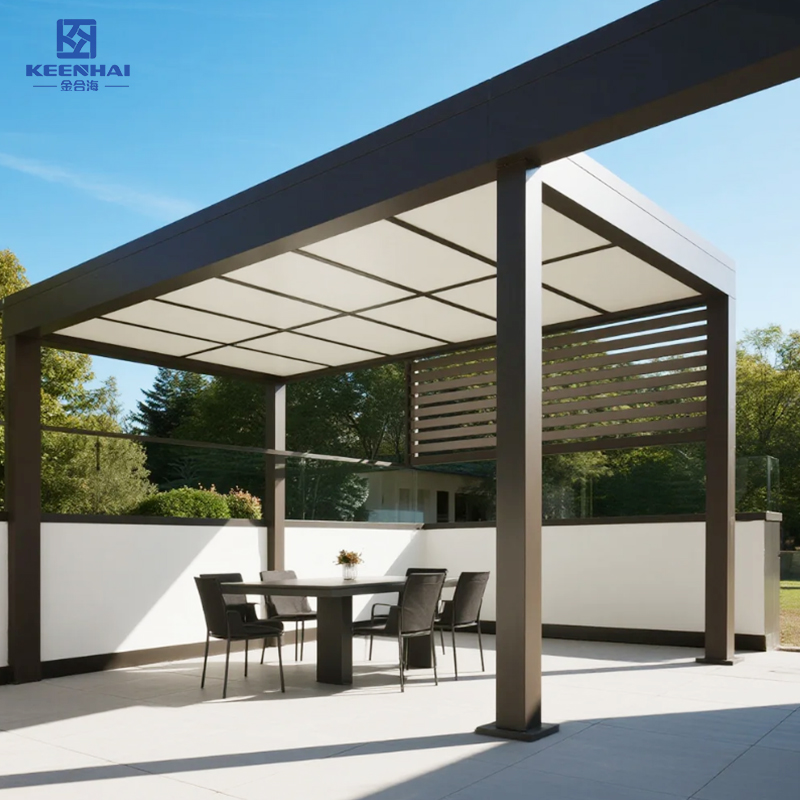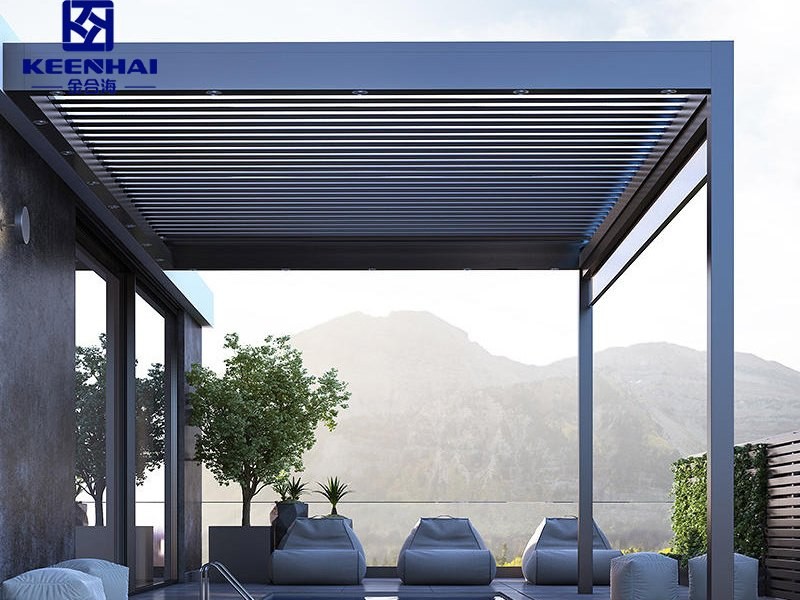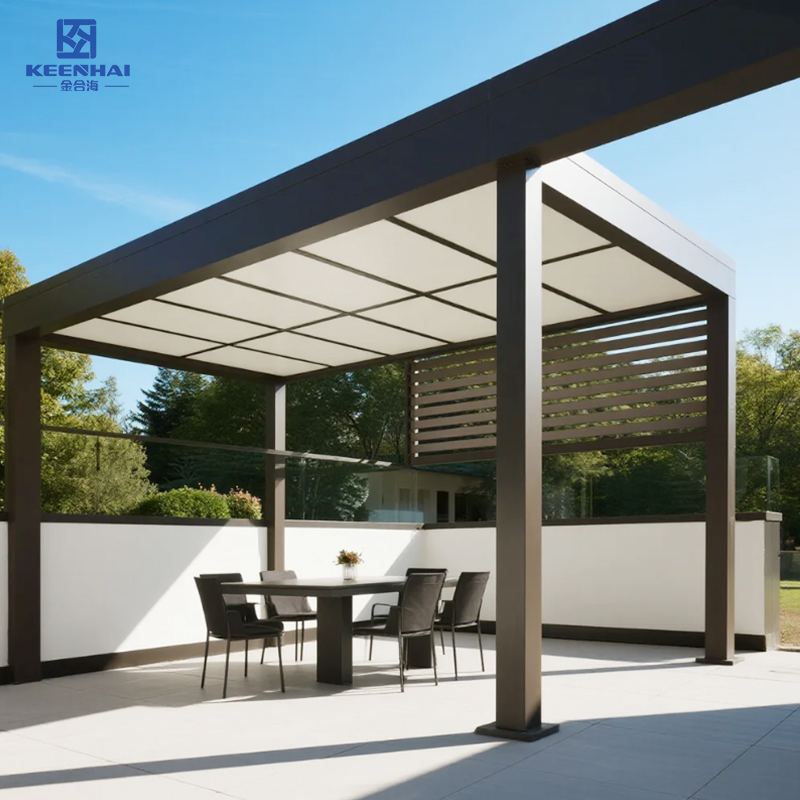
1. Cost and Value Considerations
1.1 Initial Investment vs. Traditional Pergolas
On average, a basic wood pergola might run you between $2,000 and $5,000. A powder-coated louvered pergola, on the other hand, usually starts around $8,000 and can climb higher depending on automation and custom features. While that difference looks sharp upfront, the math changes when you look at lifespan. A timber structure might last 10–12 years before major repairs or replacement, while a modern aluminum system often goes past 20 years with minimal upkeep.
| Type of Pergola | Average Initial Cost | Typical Lifespan | Approx. Cost per Year |
|---|---|---|---|
| Wooden Pergola | $2,000–$5,000 | 10–12 years | $200–$400 |
| Vinyl Pergola | $3,000–$6,000 | 12–15 years | $200–$350 |
| Aluminum Louvered System | $8,000–$15,000+ | 20–25 years | $320–$600 |
When you spread the investment across decades of use, the “expensive” option starts looking like a cost-efficient one.
1.2 Long-Term Savings on Maintenance
A family in Florida installed a cedar pergola fifteen years ago. By now, they’ve already replaced beams twice, spent weekends sanding, and paid painters every other summer. Their neighbor across the street put in a modern outdoor louvered system made of aluminum. Outside of rinsing off pollen and the occasional hardware check, they’ve had no major costs. Over time, that difference easily offsets the higher initial outlay.
For buyers who search phrases like custom louvered pergola design or buy aluminum pergola online, the real draw isn’t just the look—it’s the convenience of not pouring money and hours into upkeep.
1.3 Impact on Property Value
In real estate, a backyard with a sleek shade structure can swing a deal. Walk into a suburban listing with a covered patio, and buyers instantly picture summer barbecues or rainy-day gatherings under the louvers. Outdoor upgrades like these consistently rank among the top features that boost resale appeal. According to the National Association of Realtors, homes with well-designed outdoor living areas often recover 50–80% of the project cost at resale.

2. Functionality and Everyday Use
2.1 Adjustable Shade and Sunlight Control
One of the main reasons people invest in a louvered pergola is the ability to tilt the slats for precise sunlight control. Unlike a fixed wooden structure that either blocks or lets in all the light, these adjustable systems give you options throughout the day. In the morning, you might want the panels angled open to catch the warmth of the sun. By noon, you can rotate them shut to create dense shade over your outdoor dining table.
Think about a rooftop patio in Phoenix. Temperatures can climb well above 100°F, and without shade, the space is practically unusable. With an automated louvered roof system, the homeowner taps a remote control and adjusts the angle from 0° to 130°. That flexibility turns a harsh, exposed area into a comfortable lounge zone for family and guests.
For buyers comparing shade coverage, a simple breakdown looks like this:
| Louver Angle | Light Exposure | Typical Use Case |
|---|---|---|
| 0° (Fully Closed) | Full Shade / Rain Block | Midday protection, light rain shelter |
| 45° (Partially Open) | Filtered Sunlight | Morning coffee, reading outdoors |
| 90° (Open Vertical) | Maximum Sunlight | Winter warmth, plant growth |
This is why more homeowners search for terms like modern outdoor louvered system when they’re looking to upgrade. It’s not just about shade; it’s about having control.
2.2 Protection Against Rain and Weather
In regions with unpredictable weather, a fixed pergola is often useless the moment clouds roll in. With a louvered system, rain doesn’t mean retreating indoors. Once the panels are fully closed, built-in gutters channel water toward downspouts, keeping the patio floor dry.
Take the example of a coastal home in Seattle. The family hosts dinner parties outdoors, and sudden showers are common. With a aluminum louvered roof gazebo, they don’t have to move the table setting inside when the weather changes. Guests continue eating under shelter, while rainwater quietly drains away.
For those who live in snowy climates, durability is key. Heavy-duty aluminum louvers are engineered to withstand significant snow loads. Some models even have automatic sensors that close the roof at the first sign of rain. That kind of integration isn’t just a luxury—it’s a practical feature that protects furniture, electronics, and flooring.
2.3 Year-Round Outdoor Living Benefits
A traditional pergola is often a summer accessory. Once fall comes around, it sits unused. In contrast, an aluminum pergola with motorized louvers extends usability throughout the year.
Picture a backyard in Chicago: during the summer, the louvers stay open for airflow during BBQ nights. In October, the owner adds infrared heaters along the beams, closes the roof halfway, and suddenly the patio becomes a warm autumn retreat. During spring rains, the family keeps the roof sealed tight and still enjoys being outside without worrying about wet cushions.
Adding accessories is straightforward. Homeowners frequently integrate:
-
LED lighting strips for evening gatherings.
-
Ceiling fans for circulation during humid months.
-
Drop-down screens for mosquito control.
-
Outdoor heaters to keep the space usable in winter.
This transforms the pergola from a seasonal shade into a fully functional extension of the home. Buyers often describe it as creating an extra outdoor room—one that adapts to the weather instead of dictating when you can use it.

3. Material Quality and Durability
3.1 Aluminum vs. Wood vs. Vinyl Options
When it comes to outdoor structures, the choice of material is everything. Aluminum pergolas stand out because they’re engineered to last decades without bending, cracking, or swelling. Wood has a timeless charm, but it demands regular staining and sealing. Vinyl, while marketed as “low maintenance,” often becomes brittle after years of sun exposure.
Imagine a homeowner in Texas who first installed a cedar pergola. Within five years, termites and warping beams forced a rebuild. This time, they opted for a modern aluminum gazebo. The difference was immediate—no more sanding, no chemical treatments, and the finish remained sleek even in intense summer heat.
Here’s a clear side-by-side:
| Material | Strengths | Weaknesses | Lifespan (Avg.) |
|---|---|---|---|
| Wood | Natural look, warm aesthetic | Susceptible to rot, pests, high upkeep | 10–15 years |
| Vinyl | Affordable, low short-term care | Can fade, crack in UV exposure | 12–15 years |
| Aluminum | Durable, rust-resistant, modern design | Higher upfront cost, heavier install | 20–25+ years |
This comparison shows why buyers searching for buy aluminum pergola online are often focused on long-term value rather than just upfront savings.
3.2 Resistance to Rust, Fading, and Wear
Unlike painted steel, aluminum pergolas are powder-coated, which means the finish fuses to the metal and creates a weatherproof shell. That’s why they resist rust in coastal climates where salty air typically eats away at standard metals.
Consider a beachfront villa in California: a traditional steel structure showed corrosion within two years. Meanwhile, their neighbor’s aluminum louvered system still looked brand new after constant salt exposure. The powder coating also prevents fading from UV rays, so the structure keeps its modern appeal year after year.
For buyers comparing brands, working with a trusted aluminum pergola supplier ensures the coating and hardware meet international standards. Cheap knock-offs may look similar at first, but the difference shows after a few winters or heavy rain seasons.
3.3 Expected Lifespan with Proper Care
With basic cleaning—like spraying off pollen or wiping down the louvers every season—aluminum pergolas can last well over two decades. Automated systems may require occasional motor checks, but those parts are designed for longevity too.
Think of it like a car: if you drive it gently and service it once in a while, it lasts longer than expected. A family in Denver shared that their aluminum pergola has been standing strong for over 18 years, with no visible rust or sagging louvers. They only resealed some fasteners after a heavy snowstorm, but otherwise, it has been a “set it and forget it” investment.
In contrast, their neighbor’s vinyl pergola developed hairline cracks from winter freeze-thaw cycles, proving once again why material quality makes such a difference.

4. Design and Customization Options
4.1 Modern Aesthetic Appeal
One of the biggest reasons homeowners choose a louvered pergola over traditional wood structures is design. The clean aluminum lines give a sharp, modern look that blends well with both minimalist homes and more elaborate villas.
Picture a newly built residence in Miami: floor-to-ceiling glass walls, neutral tones, and a rooftop deck. Instead of a bulky wooden pergola, the owner installed a sleek louvered pergola finished in matte black. The adjustable louvers didn’t just add comfort—it visually extended the home’s architecture, almost like it was designed as part of the original build.
Color customization also plays a role. While black, white, and gray are common choices, powder coating allows for earthy bronze tones or even wood-grain finishes that mimic cedar but without the upkeep. This flexibility makes it possible to balance modern outdoor louvered system design with personal style.
4.2 Integration with Outdoor Spaces
A pergola is rarely a standalone feature. The best results come when it feels like a natural extension of the property.
For example, in a suburban backyard in Sydney, the homeowner wanted a smooth transition from indoor dining to outdoor entertaining. They extended their deck and added an aluminum pergola house that attached directly to the rear façade. With glass sliding doors, the indoor and outdoor spaces flowed seamlessly, giving the impression of a much larger living area.
Integration isn’t just about attachment. Freestanding gazebos in garden corners or by pools also create focal points. Adding matching flooring—like stone pavers or composite decking—ties the structure into the overall landscape design. For those seeking long-term property value, it’s these details that make the difference.
4.3 Add-Ons: Lighting, Heating, and Screens
Customization doesn’t stop at the frame. A big appeal of aluminum pergolas is how easily they accept add-ons.
-
Lighting – Integrated LED strips along the beams allow evening gatherings without the need for string lights. Some models even offer dimmable options controlled by a smartphone app.
-
Heating – Infrared heaters can be mounted along the frame, making chilly autumn evenings comfortable for outdoor dinners.
-
Screens – Motorized drop-down screens add privacy and block insects, effectively turning the pergola into a hybrid outdoor room.
A couple in Toronto shared that their backyard wasn’t usable past 8 p.m. due to mosquitoes. Once they installed retractable screens on their pergola, paired with warm-toned LEDs, the patio instantly transformed into their favorite night-time hangout.
These add-ons don’t just increase comfort; they push the pergola into a category of “multi-season living space.” That’s why many homeowners search for custom louvered pergola design when planning upgrades—they want something beyond a shade cover, a true extension of their lifestyle.
